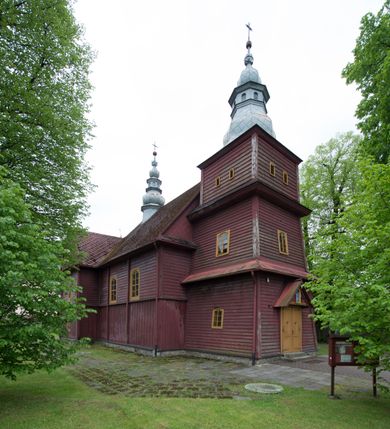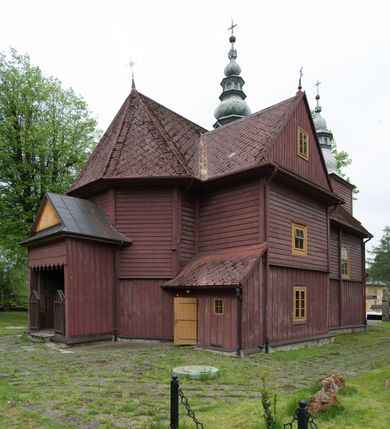
St. Clement's Church
History of work
The parish with the church was mentioned in the census of the Peter's pence in the years 1325–1327. Probably another wooden church of St. Clement was mentioned in the records of the visitation from 1596. Spytek Wawrzyniec Jordan (d. 1596) was the patron at that time. The temple had three unconsecrated altars, a stone baptismal font and a crucifix on the chancel arch. In the record of the visitation of 1618, the altars were already described as consecrated, and three bells were mentioned in the church, including two in the bell tower (it is not known whether the tower was free-standing or built into the façade) and the third one in the church. In the subsequent visitation documents from 1665, the altars' invocations were specified. High altar was dedicated to the Assumption of Mary and included the image of Mary, on the right there was a reredos with an image of the Blessed Virgin Mary, and to the left – a brick altar with a new structure. The church also had choir-stalls and pews, a pulpit and a baptismal font in the middle. The visitation records of 1730 mention five altars, the high altar of St Clement, the second altar in the chancel of the Coronation of the Blessed Virgin Mary, the third altar with a simple figure of Christ Crucified in the nave on the right and the elegant structure of the Blessed Virgin Mary on the left, and the fifth reredos with a new structure, not yet polychromed. The pulpit was suspended from the chancel arch on the right side. Probably at the beginning of the 18th century, part of the furnishings has been replaced replaced with new ones and its quantity has been increased. The Church of St. Clement was then described in the visitation records from 1747–1748, when Adam Jordan of Zakliczyn (d. 1763) had the right of patronage over it. Church furnishings included an old-style crucifix on the chancel arch, a pulpit attached to the chancel wall, an organ loft above the main entrance to the church in the western part of the main nave with an organ and a seven-tone positive organ. There was one pew in the chancel, on the left. The church also included one old, repaired confessional. The records describe five altars, the main altar of St. Clement with a wooden mensa and tabernacle, the altar of the Blessed Virgin Mary in the nave on the left, the altar of the Coronation of the Blessed Virgin Mary with a stone mensa, the altar of the Virgin Mary with a wooden mensa on the same side, the reredos of St. Mary Magdalene with a stone mansa and a stone baptismal font, which was consecrated that year. The church had a wooden bell tower with new slatting bought thanks to the parishioners and two bells. In 1760, the altar of St. Andrew was erected (from which the painting has been preserved). The church was destroyed by floods of the neighbouring stream. The present church was built in 1780 by the foreman Antoni Wacławik. It was placed in a different place than the previous one, on a nearby hill. The new high altar for the temple was probably built around 1780. A Garden of Gethsemane was added to the outer wall of the chancel in 1839. From the south, the nave is adjoined by the later erected church porch. The church was renovated at the turn of the 19th and 20th centuries. In 1910, the interior of the temple was covered with polychrome made by Marian Szczurowski.
Abstract
The first wooden church in Trzemeśnia was mentioned as early as the fourteenth century, and another in the sixteenth century. The former temple was destroyed by the floods of the neighboring stream. The present church was built in 1780 by the foreman Antoni Wacławik. The church in Trzemeśnia represents a trend in the 18th century wooden construction, in which traditional spatial solutions were applied, showing the changes in the construction - characteristic in the 18th century.
Other works of this author
Persons related to work
Other works from this place
Other works from this year
Similar works
How to cite?
Paulina Kluz, "St. Clement's Church", [in:] "The Sacred Lesser Poland Heritage", 2026, source: https://sdm.upjp2.edu.pl/en/works/st-clements-church-1









































































